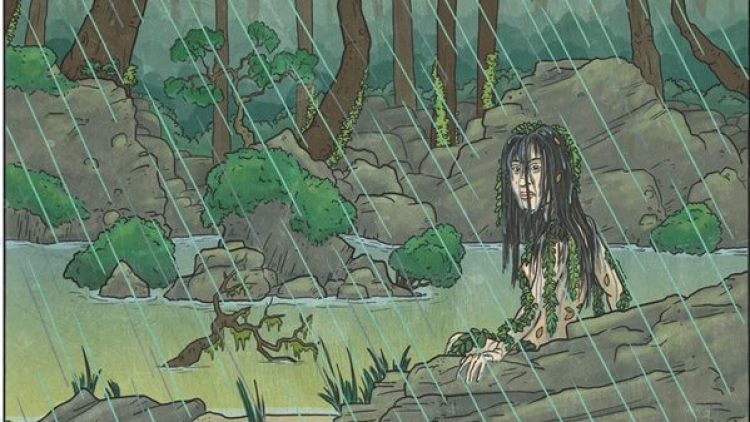
when Horror Yearbook – Nure onago is a fascinating yōkai from Japanese folklore, steeped in mystery and sadness. These creatures appear as young girls, drenched from head to toe, with matted wet hair. The term “nure onago” translates to “wet woman,” capturing the essence of these enigmatic figures. They are often found wandering near swamps, rivers, and coasts, typically during rainstorms. This ghostly image has deep ties to traditional Japanese eroticism and sorrow.
Nure onago are typically depicted as disheveled young girls, their bodies drenched in water. Their appearance evokes a sense of sadness and loneliness, with their wet, matted hair hanging loosely over their faces. They are often covered with dead leaves and other debris, making their presence even more haunting. This strange, eerie image of a young girl wandering alone, soaked in water, stirs a blend of sympathy and fear in those who encounter her.
The wetness is a key feature of the nure onago’s appearance. Their constant dripping bodies are soaked from head to toe, creating a disturbing aura. The lingering smell of mildew and swamp water adds to their unsettling presence. Although these figures do not harm anyone physically, their unrelenting presence can emotionally and mentally affect those who encounter them.
“Read more: Maximizing Your Fitness Potential for Total Wellness”
Travelers in regions such as Shikoku and Kyūshū occasionally have strange encounters with a mysterious figure. These creatures are often spotted near coasts and rivers, especially on rainy nights. At first glance, the sight of a young girl lost in the rain seems like a tragic, helpless figure in need of help. Most people instinctively approach, offering assistance to the soaking girl.
When a person approaches, the girl looks up and smiles. If the person returns her smile, she will follow them, remaining by their side indefinitely. This interaction might seem innocent at first, but it soon becomes an exhausting and overwhelming experience. As she follows, the constant dripping and the smell of swamp water can drain the individual emotionally and mentally, ruining the rest of their life.
The only way to escape the influence of the creature is to avoid returning her smile. If a person ignores the smile and does not engage, the figure will leave. Unfortunately, by the time her true nature is realized, it is often too late.
Nure onago is believed to be born from the profound grief and sorrow of widows, particularly those who lost their husbands at sea. In Japan, the sea has long been a place of danger, where many sailors meet untimely deaths. The widows of these sailors, left to mourn the loss of their husbands, experience deep feelings of longing and heartache. This intense emotional energy, rooted in loss, manifests in the form of the nure onago.
The spirit of the nure onago represents the amplified desire of these grieving women to reconnect with their lost husbands. This yearning becomes so powerful that it materializes into a yōkai, the wet woman, seeking attention and comfort. The nure onago’s wandering in search of someone who will acknowledge her is a reflection of the widows’ own desperate need for emotional connection and closure.
Nure onago shares similarities with another yōkai, the hari onago. Both are often depicted as young girls, and both are linked to the themes of loss and longing. However, while hari onago tends to be more violent in nature, nure onago represents a less aggressive form of grief. These two yōkai are sometimes grouped together under the term “waraionago,” meaning “smiling girls.” The overlap between these two entities suggests a deeper connection, especially considering their shared presence in the island of Shikoku.
It is important not to confuse the nure onago with nure onna, another well-known yōkai in Japanese folklore. Nure onna is much larger and more dangerous than nure onago. While both creatures share a connection to water and wetness, nure onna’s violent tendencies make her far more threatening. In contrast, nure onago is a more passive entity, driven by loneliness and loss, rather than a desire to cause harm. Despite their similar names, these two yōkai are distinct, with nure onago being a more sorrowful figure.
“Read more: The Genderuwo Phenomenon: Understanding the Cultural Impact in Indonesia”
The nure onago embodies the profound emotional states of grief, loss, and longing. Her wetness symbolizes the tears of a grieving widow, while her constant wandering represents the endless search for comfort and closure. The interaction with the nure onago serves as a metaphor for how unaddressed grief can cling to a person, draining their emotional energy over time. Her figure, drenched in water and debris, illustrates the burden of unhealed emotional wounds.
The nure onago’s presence in folklore also reflects societal attitudes toward women, particularly widows, in historical Japan. Widows were often left to fend for themselves after the loss of their husbands, especially in rural communities. Their sorrow and desire for connection are encapsulated in the figure of the nure onago, making her a symbol of the emotional struggles faced by women of that time. and more dangerous yōkai.